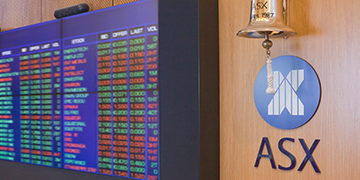Harmoney Corp (ASX: HMY) had two related goals when it listed on ASX in 2020: access to capital and making a bigger push into the Australian personal-lending market.
The New Zealand-based lender had been constrained by a lack of capital. Harmoney believed an Initial Public Offering (IPO) and dual listing on ASX and NZX was its best funding option.
Harmoney is growing quickly. Since originating its first loan in 2014, Harmoney has become the largest consumer-direct money platform in NZ and Australia. It has a NZ$557 million group loan book at end-December 2021.
The company’s innovative crediting-decisioning engine (Libra™) is currently powered by behavioural data insights in Australia and New Zealand, and the underlying technology has global applications.
“Harmoney quickly emerged from an NZ start-up to a more established company with an online lending platform that has global application,” says CEO David Stevens. “But Harmoney’s capital position when privately owned was holding it back. We saw an opportunity to raise a significant amount of capital via an IPO and benefit from being dual-listed on ASX and NZX.”

Harmoney raised A$92.5 million from an IPO in November 2020. It chose a primary listing on ASX and a secondary listing on NZX as a “Foreign Exempt Issuer”. This means Harmoney complies with ASX Listing Rules and follows ASX Corporate Governance Guidelines and Principles.
In doing so, Harmoney joined a vibrant group of local and international financial-technology (fintech) companies that have listed on ASX in the past five years.
Stevens has strong experience in fintech and public markets. The 42-year-old was formerly CEO of FlexiGroup, a diversified financial services group. Under his leadership, FlexiGroup grew from a small enterprise to a billion-dollar company in the S&P/ASX 200 index (he left in February 2017). FlexiGroup was last year rebranded as Humm Group (ASX: HUM).
Stevens joined Harmoney in September 2019 to lead its next phase of growth. A key part of that was an IPO and dual listing on ASX and NZX to expand the business. He relocated to Auckland.
ASX asked Stevens about Harmoney’s decision to list on ASX and his insights for other privately owned NZ fintechs that want to raise capital. Here is an extract of his response:
On the Board: David, why did Harmoney raise capital on public markets rather than privately?
David Stevens: When it was a privately owned company, Harmoney successfully raised capital through Series A, B, and C funding rounds with private investors. We had plenty of interest from private-equity firms to make a larger investment in Harmoney.
Private capital has its place, but emerging fintech companies in NZ have to give away a lot of equity to get those funding rounds done. We were concerned that a cornerstone private-equity firm would want control of Harmoney. There might be a lot of private capital around, but we found this type of capital can be risk-averse and unwilling to back online-platform businesses that are yet to make a profit unless private equity firms have a controlling or monitoring interest.
Having led an ASX-listed company for several years, I was comfortable with public markets and understood the benefits of being listed on ASX and NZX. The Board believed an IPO and dual listing was the best way for Harmoney to raise capital and realise its potential.
OTB: Why did Harmoney choose a primary listing on ASX and a secondary listing on NZX?
DS: The main reason was depth of capital. While Harmoney is proud to have been founded in NZ, the reality is ASX is a much larger market because of the size of its superannuation sector. Australia has more fund managers who invest in fintech companies and understand the sector, and more stockbroking analysts who research companies such as Harmoney.
ASX also has several comparable listed peers for Harmoney, for example, WISR (ASX: WZR), Plenti Group (ASX: PLT), and MoneyMe (ASX: MME). An ASX listing means Harmoney’s performance and valuation could be compared against other peer companies.
OTB: Why didn’t Harmoney choose a sole listing on ASX?
DS: Harmoney has a well-known brand in NZ and more than 10,000 active investors there on our now legacy peer-to-peer lending platform. We wanted to provide an opportunity for those investors to invest in Harmoney and buy and sell its shares via NZX. Harmoney believed a dual listing on ASX and NZX provided the best of both worlds for the company.
OTB: How does an ASX listing support the company’s growth plans in Australia?
DS: Our Australian growth plans were an important factor in our listing decision. As a private company, Harmoney hadn’t made a sufficient push into the much larger Australian market because of capital constraints. Harmoney wanted to grow much faster in Australia and believed an ASX listing would help raise its profile with investors and customers in that market.
At the time of the IPO, Harmoney’s revenue was split approximately 80/20 between NZ and Australia. That is more like 70/30 now based on the company’s FY21 result; Harmoney reported an Australian-dollar loan book of $135 million. We’re pleased with Harmoney’s performance in Australia and see much potential to grow in that market.
OTB: What does Harmoney’s share register look like after the IPO?
DS: About 70 per cent of Harmoney is still owned by NZ investors, but the majority of the IPO was taken up by Australian investors. About a quarter of Harmoney’s register joined through the IPO (the rest is held by existing shareholders). Of that quarter, the split between institutional and retail investors is approximately 70/30. More retail investors have joined Harmoney’s register since listing, which is pleasing.
OTB: How has Harmoney’s stock liquidity been since listing?
DS: The data we receive from ASX shows our liquidity is relatively okay for the amount of shares that aren’t held in escrow. However, increasing our share liquidity is definitely a focus for Harmoney over time. At IPO approximately 75 per cent of Harmoney’s share register was escrowed, which affects liquidity. The first release of escrow shares has now happened and the second is due in February 2022. That will help liquidity.
OTB: How important is index inclusion to Harmoney?
DS: The potential to become part of a key index on ASX was another factor in Harmoney’s decision to have a primary listing on ASX. The company’s goal is to get into the S&P/ASX 300 Index and then the S&P/ASX 200 index. When your company is part of an index, its shares are automatically held by a growing number of index funds. That’s important for share liquidity and attracting index and active funds to the share register.
OTB: What advice would you give other NZ fintechs about listing?
DS: The company’s management team and/or Board needs to have experience in running a listed company. If you haven’t been at the coalface of running a listed company, you might not understand the work required in investor relations. You can’t just do an IPO, raise capital and go back to purely running the business. As CEO, you have to keep meeting with investors, and communicate your company’s vision, strategy and performance.
You need a long-term view and real conviction in your company’s strategy. Life as a listed company can be bumpy at times. Operationally, your company can be performing well, but the share price could be down for a range of factors. You have to see it through and focus on long-term value creation for shareholders.
Another insight I’ve had from running listed companies is the importance of peer companies. When you list on an exchange that has a group of similar listed companies in your sector, it’s easier to attract fund managers and research. Because investors are already familiar with your sector, it’s more convenient for them to follow your company. You don’t want to be the only company in your sector listed on an exchange, or part of a small group that is not researched by brokers.
OTB: Have you attracted broking research coverage since listing?
DS: Ord Minnett and Jarden Australia cover Harmoney (they were joint leaders on the IPO). We hope to attract more research coverage over time as Harmoney grows.
OTB: What was it like doing an IPO during Covid?
DS: It was very efficient. I probably did 50 or more investor meetings in total, and from that Harmoney established a group of cornerstone investors. We saved a lot of time not having to travel overseas or meet face-to-face for investor meetings. Since listing, I’ve presented virtually and in person to many different groups of investors, including at the ASX Small- and Mid-Cap Conference.
Find out more
Find out more about the top New Zealand companies that are listed on ASX.




